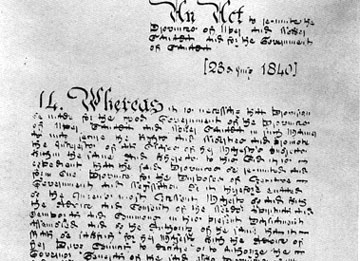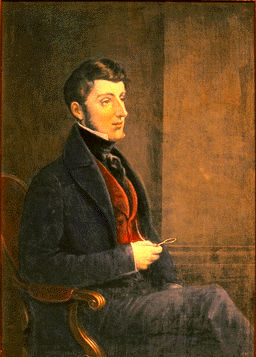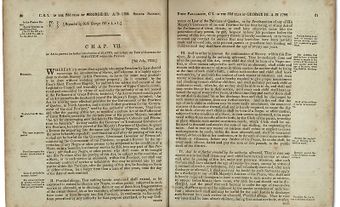
Durham Report
Following the violent rebellions of 1837–38, Lord Durham was sent in 1838 to determine the causes of unrest. The solution he recommended in the Durham Report (1839) was to unify Upper and Lower Canada under one government.
Lord Durham proposed a united province to develop a common commercial system. A combined Canada would also have an overall English-speaking majority. This would help control the divisive forces Durham saw in the mostly French Lower Canada. It would also make it easier to introduce responsible government, which he advocated. Britain agreed to the union, but not to responsible government.
The Act's Passage
The legislation to establish the new Province of Canada was introduced in the British House of Commons in May 1839. In September, Charles Poulett Thomson (later Lord Sydenham) was sent as governor general to get Canadian consent to the Act. He obtained consent from Lower Canada in November and from Upper Canada in December. The two legislative bodies were fused by Lower Canada Chief Justice James Stuart early in 1840. The Act was passed by the British Parliament in July 1840. It was proclaimed on 10 February 1841 in Montreal.

How it Worked
The Act had a number of main provisions. It established a single parliament with an equal number of seats for each region. The two areas were now called Canada East (formerly Lower Canada) and Canada West (formerly Upper Canada). The two regions’ debts were consolidated. A permanent Civil List (the list of officials on the government payroll) was created. The French language was banished from official government use. Specific French Canadian institutions related to education and civil law were suspended.
The Act naturally aroused considerable opposition. In Upper Canada, the Family Compact opposed union. In Lower Canada, religious and political leaders reacted against its anti-French measures. In fact, the Act was unfair to Lower Canada, which had a larger population and a smaller debt. However, both Canadas agreed to work within the Act. This was largely due to the liberal influence of the united Reform Party. It was led by Louis Lafontaine in Canada East and Robert Baldwin in Canada West.
Within 15 years, many of the Act’s unjust clauses were repealed. Economic prosperity brought wealth and growth to the united colony. Responsible government, granted in 1848, eventually allowed for changes to many of the Act's financial and constitutional provisions.
See also: Act of Union: Timeline; Act of Union: Editorial.

 Share on Facebook
Share on Facebook Share on X
Share on X Share by Email
Share by Email Share on Google Classroom
Share on Google Classroom


